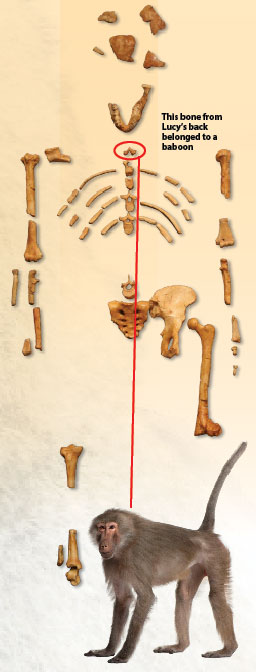Lucy’s Baboon Backbone
 Main image © 123rf.com/JohnnyLye
Main image © 123rf.com/JohnnyLyeThe famous ‘Lucy’ (Australopithecus afarensis) has long been an icon of evolution, portrayed in museums and textbooks as an upright-walking ape-woman, ‘dated’ to about 3.2 million years old. Now, over 40 years after her initial discovery in Ethiopia, paleoanthropologists have found that one of Lucy’s bones does not actually belong to her, but to a baboon.
These scientists from the American Museum of Natural History in New York and New York University were collaborating on a fresh reconstruction of Lucy’s skeleton. But they realized that one of the bones in her spine seemed out of place—it was too small compared to the rest of her spinal column.1 Further investigation revealed that this bone was more weathered than, and had a different texture from, the rest of her vertebrae—something Lucy’s discoverer, Donald Johanson, had noted when first describing the skeleton.2
This texture difference was overlooked for decades because most scientists are only allowed to work with casts of Lucy’s bones, which lack some of the details of the originals. But, after becoming suspicious, one of the researchers, together with vertebral specialist Marc Meyer from Chaffey College in Rancho Cucamonga, California, compared the bone in question to the vertebrae of other animals. They soon concluded that it most likely belonged to an extinct species of baboon.
What’s the significance?

While this bone was not particularly crucial in determining Lucy’s posture or locomotion, let alone her status as a supposed human ancestor, that does not make this revision insignificant. The fact that this bone was incorrectly assigned to Lucy for 40 years doesn’t inspire much confidence that evolutionists are drawing the right conclusions about human origins elsewhere.
When reading reports on this discovery, one gets the sense that evolutionists are engaging in damage control. They reassure the public with statements like, “the mislabelled baboon bone fragment doesn’t undermine Lucy’s important position in the evolution of our lineage.”1 And they attempt to put a positive spin on this news, saying, “This is how science progresses; we don’t leave things unexamined.”2 Except, there are plenty of basic assumptions evolutionists are not willing to examine, like the naturalistic evolutionary paradigm itself.
In reality, Lucy’s borrowed bit of baboon backbone illustrates how easy it is, even for trained scientists, to make mistakes when reconstructing the past. What is claimed to be settled science today can be overthrown tomorrow. This is especially true when it comes to historical science—the method of piecing together the unobservable, unrepeatable past from limited, circumstantial clues in the present.3 Claims about ape-men (and ape-women), in particular, are often based on partial or fragmentary remains which lend themselves to a wide variety of interpretations. This misidentified backbone is a good reminder of why, when we’re seeking to discover the true history of the world, our final authority should be the eyewitness, infallible record of God-breathed Scripture rather than the opinions of fallible men.
References and notes
- Barras, C., Baboon bone found in famous Lucy skeleton, newscientist.com, 10 April 2015. Return to text.
- van Hilten, L.G., Why Lucy’s baboon bone is great for science (and evolutionary theory), elsevier.com, 15 June 2015. Return to text.
- Batten, D., ‘It’s not science’, 18 September 2014; creation.com/its-not-science. Return to text.









Readers’ comments
Comments are automatically closed 14 days after publication.